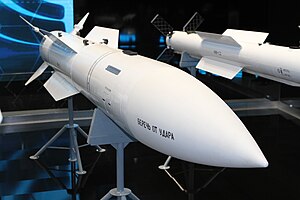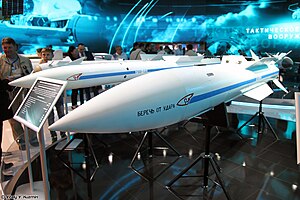| Vympel R-37M NATO reporting name: AA-13 Axehead | |
|---|---|
 R-37M (under the export designation RVV-BD) at 2013 MAKS Airshow R-37M (under the export designation RVV-BD) at 2013 MAKS Airshow | |
| Type | Long range, hypersonic air-to-air BVR missile |
| Place of origin | Russia |
| Service history | |
| In service | 2019 |
| Used by | Russian Aerospace Forces |
| Production history | |
| Designer | Tactical Missiles Corporation |
| Designed | 1980s |
| Manufacturer | Vympel MKB |
| Produced | 1985 |
| Variants | R-37M (export: RVV-BD) |
| Specifications (R-37M approximation) | |
| Mass | 510 kilograms (1,120 lb) |
| Length | 4.06 metres (13 ft 4 in) |
| Diameter | 38 centimetres (15 in) |
| Wingspan | 72 centimetres (28 in) |
| Warhead | HE, fragmention |
| Warhead weight | 60 kg (135 lb) |
| Propellant | Boost-Sustain Solid Rocket |
| Operational range | 150–400 km (93–249 mi) Up to 200 kilometres (120 mi) (RVV-BD) |
| Maximum speed | Mach 6 (7,400 km/h; 4,600 mph) 2,500 kilometres per hour (1,600 mph) (RVV-BD) |
| Guidance system | Inertial with mid-course update, semi-active and active radar homing |
The Vympel R-37 (NATO reporting name: AA-13 Axehead) is a Russian hypersonic air-to-air missile with very long range. The missile and its variants also had the names K-37, izdeliye 610 and RVV-BD (Ракета Воздух-Воздух Большой Дальности (Raketa Vozduh-Vozduh Bolshoy Dalnosti), "Long range air-to-air rocket"), and the NATO codenames "Axehead" and "Andi". It was developed from the R-33.
It is designed to shoot down tankers, AWACS and other C4ISTAR aircraft while keeping the launch platform out of range of any fighters that might be protecting the target.
According to Janes there are two variants, the R-37 and the R-37M; the latter conceived as having a jettisonable rocket booster that increases the range to "300–400 km" (160–220 nm). In 2023, Rosoboronexport introduced the export version of the R-37M, designated RVV-BD. It has a launch range of up to 200 kilometres (120 mi; 110 nmi) and maximum altitude of 25 kilometres (82,000 ft) with a 60 kilograms (130 lb) warhead. The missile is compatible with Sukhoi Su-57, Sukhoi Su-30, Sukhoi Su-35, Mikoyan MiG-31BM and Mikoyan MiG-35.
Design
The R-37 was developed from the R-33. For compatibility with aircraft that did not have the MiG-31's sophisticated radar, the semi-active seeker was replaced with a variant of the Agat 9B-1388 active seeker. Similarly, folding tail controls allow semi-conformal carriage on planes that are not as big as the MiG-31.
Mid-body strakes enhance lift and hence increase range. According to Defence Today, the range depends on the flight profile, from 80 nautical miles (150 km) for a direct shot to 215 nautical miles (398 km) for a cruise glide profile.
The R-37M designation has since been used for a modernized variant of the missile, also known as RVV-BD (Raketa Vozduh-Vozduh Bolshoy Dalnosty, or Long-Range Air-to-Air Missile). R-37M's range exceeds 200 km, and it is capable of hypersonic speeds (~Mach 5). It will be carried by the modernized MiG-31BM interceptors and Su-35S and Su-57 multirole fighters.
A further derivative designed for internal carriage in the Su-57, designated as Izdeliye 810, has folding rear fins, shorter strakes, and updated seeker and motor.
The missile can attack targets at altitudes of 15–25 kilometres (49,000–82,000 ft), guided semi-actively or actively through the Agat 9B-1388 system.
History
The missile was designed in the early 1980s and first flown in 1989. Testing of the R-37 continued through the 1990s, and in 1994, a trial round scored a kill at a range of 162 nautical miles (300 km). However, the program appears to have been dropped around 1998 on grounds of cost.
Work on the missile appears to have restarted in late 2006, as part of the MiG-31BM program to update the Foxhound with a new radar and ground attack capability.
In 2018, the R-37M had finished its operational validation tests.
Zvezda TV reports have recorded the Su-35 carrying the R-37, apparently as part of an air combat loadout. In this configuration, the craft carries two R-73s in the central wing pylon, two R-77s slung underneath the engine nacelles, and two R-37s on the hardpoints between the engines, with an option to carry a few more missiles, such as a Kh-31 anti-radiation missile.
Operational history
The R-37M has, since October 2022, been the main threat against the Ukrainian Air Force. During the 2022 Russian invasion of Ukraine, MiG-31 aircraft have reportedly shot down several Ukrainian aircraft, mainly by using the long range R-37. By remaining at high speed and high altitude, MiG-31s have been able to operate virtually unopposed due to Ukrainian fighters lacking range, speed, or altitude necessary to engage the MiG-31. The Ukrainian Air Force lacks fire and forget missiles. They relied on the R-27 missiles, both the R-27R and R-27ER. The Ukrainian pilot must illuminate the Russian aircraft with their radar to guide the missile to the target. Russian pilots firing active radar, fire and forget, R-77 give the Russian pilots the ability to launch their missiles and then take evasive action. Ukrainian pilots were forced to "exploit ground clutter and terrain-masking to get close enough to fire before being engaged".
A report by the Royal United Services Institute (RUSI) states that in October some six R-37Ms were being fired at the Ukrainian Air Force a day. The Su-35S is also used as a carrier for the R-37M. Four MiG-31 were also deployed to Crimea at the Belbek Air Base in mid 2022.
In August 2022, Russian forces maintained a Combat Air Patrol of either a pair of Su-35S or MiG-31s on station to shoot down Ukrainian aircraft. The RUSI stated: "The VKS has been firing up to six R-37Ms per day during October. The extremely high speed of the weapon, coupled with very long effective range and a seeker designed for engaging low-altitude targets, makes it particularly difficult to evade."
In February 2023, Ukraine obtained wreckage of a R-37M which would be of interest to Ukraine and Western countries.
According to a Russian source, the missile is carried by the Su-35S and Su-57 fighters, and the MiG-31BM interceptor.
According to Ukrainian pilots, the R-37M isn't achieving a lot of "hard kills", the destruction of actual Ukrainian aircraft. However, their launch forces pilots to abandon their current mission and take evasive action. Ukrainian pilots believe that the only defence is for their allies to supply them with F-16 fighter jets and AIM-120 AMRAAM missiles. While it won't close the distance, Ukrainian pilots hope that it will push back the effective range of missiles like the R-37. However according to Ukrainian official, Ukraine is looking for opportunities to modernize the F-16 Block 20 MLU fighter jets planned for transfer. Early generation AN/APG-66 radar of older F-16 Block 20 MLU only has similar range of Ukrainian Mig-29s and poses no significant advantage compare to current Ukrainian fighters radar over the radar of current Russian fighters used in the war such as Irbis-E and N110M Bars-M.
See also
- AIM-54 Phoenix – (United States)
- AIM-152 AAAM – (United States)
- AIM-174B ERAM – (United States)
- AIM-260 JATM – (United States)
- Novator KS-172 – (Russia)
- PL-21 – (China)
- PL-17 – (China)
- Long-Range Engagement Weapon – (United States)
- Meteor – (France, United Kingdom, Italy, Germany, Spain, Sweden)
- Astra Mark 3 – (India)
Gallery
References
- ^ "Missiles in the Asia Pacific" (PDF), Defence Today: 67, May 2005, archived from the original (PDF) on 26 January 2009
- ^ "R-37, R-37M (AA-X-13) (Russian Federation), AIR-TO-AIR MISSILES - BEYOND VISUAL RANGE". janes.com. 12 January 2009. Archived from the original on 14 September 2008.
- "RVV-BD Long-range air-to-air missile". YouTube. Rosoboronexport. 2023-08-25.
- "RVV-BD Aircraft Guided Air-to-Air Missile". Federal Service of Military-Technical Cooperation (Russia). Retrieved 2023-10-10.
- "The military tested a long-range missile for the Su-57 (In Russian)". N+1.
- Newdick, Thomas (October 5, 2020). "Russian Air-To-Air Missile Tests Signal Potential New Capabilities For Flanker and Felon". The Drive.
- Butowski, Piotr (7 February 2024). "Model Reveals New Russian Air-To-Air Missile For The Sukhoi Su-57". Aviation Week & Space Technology.
- "Управляемая авиационная ракета класса "воздух-воздух" большой дальности РВВ-БД". missile.ru. October 2011. Retrieved 26 August 2019.
- "New Russian long-range AAM integration to expand to four fighter models - Jane's 360". janes.com. 9 July 2018. Archived from the original on 13 July 2018. Retrieved 4 January 2019.
- "Какие разработки корпорации "Тактическое ракетное вооружение" скрывает фюзеляж Су-57 | Еженедельник "Военно-промышленный курьер"".
- https://www.rusi.org/explore-our-research/publications/special-resources/russian-air-war-and-ukrainian-requirements-air-defence
- "The Russian Air War and Ukrainian Requirements for Air Defence". RUSI. 7 November 2022.
- "Russia's MiG-31 Crews Are Shooting At Ukrainian Pilots From A Hundred Miles Away—And The Ukrainians Can't Shoot Back". Forbes. 8 November 2022.
- ^ Butowski, Piotr; Newdick, Thomas (10 November 2022). "Russia's MiG-31 Foxhounds Proving To Be A Threat To Ukrainian Aircraft". The Drive. Retrieved 20 May 2023.
- Forbes Staff (30 April 2022). "Ukraine's Pilots Are Flying Into Battle With Old, Dumb Missiles. It's One Reason They Get Shot Down". Forbes. Retrieved 14 November 2022.
- David Axe (10 November 2022). "Fly Low, Get Aggressive—How Ukrainian Pilots Fought The Russian Air Force To A Standstill". Forbes. Retrieved 14 November 2022.
- Sakshi Tiwari (10 November 2022). "Russia Is 'Outfoxing' Ukrainian Warplanes With Its Foxhounds; MiG-31s Prove Much Superior To Sukhoi Counterparts". EurAsian Times. Retrieved 14 November 2022.
- "It seems that the Russian Federation lost a rare MiG-31 with "Kinzhal" in the occupied Crimea, the pilot died". Sundires. 8 October 2022. Retrieved 14 November 2022.
- "Ukraine Acquires Wreckage of R-37M Russian Missile Used for Attack". hngn.com. 18 February 2023. Retrieved 20 May 2023.
- "Ukraine Seizes 'Scary' Russian R-37M Missile Wreckage Used To Launch Deadly Strikes From Su-35, MiG-31 Fighters". Eurasian Times. 14 February 2023. Retrieved 20 May 2023.
- "ЦАМТО / / Новая ракета Р-37М класса "воздух-воздух" показала в рамках СВО очень высокую вероятность поражения целей". armstrade.org.
- David Axe (30 May 2023). "With F-16s, Ukrainian Pilots Could Finally Beat Back Russia's MiG-31s". Forbes.com.
- "Ukraine Needs a Squadron of F-16s to Scare Away Russian Jets". Defense Mirror. 29 May 2023.
- "Ukraine discusses F-16 modernization". Ukrainian Military Center. 23 November 2023. Retrieved 8 January 2024.
- "Ukraine Wants Modern Radar, Latest Weapons in F-16s Jets". Defense Mirror. 23 November 2023. Retrieved 8 January 2024.
- "Assessing Ukraine's Air Defense Deterrent – Analysis". Eurasia Review. 27 May 2023. Retrieved 8 January 2024.
External links
- R-37M/RVV-BD, Vympel MKB
- R-37M
| Russian and former Soviet aircraft ordnance | |||||||||||||||||
|---|---|---|---|---|---|---|---|---|---|---|---|---|---|---|---|---|---|
| Missiles |
| ||||||||||||||||
| Rockets | |||||||||||||||||
| Aerial bombs | |||||||||||||||||
| Autocannons, machine guns |
| ||||||||||||||||
| Russian and former Soviet military designation sequences for radar, missile and rocket systems | |||||||||||||||||||||||
|---|---|---|---|---|---|---|---|---|---|---|---|---|---|---|---|---|---|---|---|---|---|---|---|
| Radar systems |
| ||||||||||||||||||||||
| Missiles |
| ||||||||||||||||||||||
| Unguided rockets |
| ||||||||||||||||||||||
| Engines | |||||||||||||||||||||||

